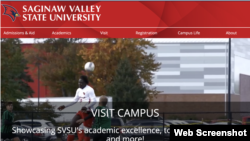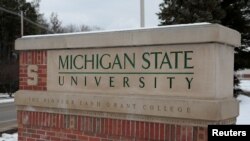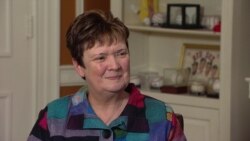Student Union
- By Julie Taboh
Education Expert Lynn Pasquerella Extols Value of Liberal Arts Education
"Liberal education is more critical than ever if we take into account our nation's historic mission of educating for democracy," Lynn Pasquerella, president of the Association of American Colleges and Universities, said.
Those statements come as an increasing number of small, liberal arts colleges in America are closing or being taken over by larger academic institutions... and as the number of international students coming to the U.S. is at an all-time high. (According to a recent report by Open Doors 2019, recently released by the Institute of International Education (IIE) and the U.S. Department of State’s Bureau of Educational and Cultural Affairs).
Pasquerella spoke in detail about this topic, and touched on many other issues in an in-depth interview with VOA earlier this month at the AAC&U offices in Washington.
The following is a transcript of the full interview.
VOA: Thank you for taking the time to sit with me today. First, tell us about your association.
Lynn Pasquerella: The Association of American Colleges and Universities has a mission of advancing the vitality and public standing of liberal education equity and quality as the foundations for excellence in undergraduate education in service to democracy.
VOA: Let's talk about the status of small liberal arts colleges across the US. Where is it right now and what's happening with them?
Pasquerella: There's a prevailing national rhetoric that calls into question the value of higher education in general, and liberal education in particular.
A number of small liberal arts colleges are at risk, in part because of this rhetoric, but also because they have served very distinctive missions. Many small, faith-based institutions in the past, had relied on the clergy, to do administrative work, to teach classes. And as their numbers are dwindling, the colleges are finding that they're having trouble keeping up with the payroll.
But there are many, many liberal arts institutions that are thriving today, and at AAC&U we believe that that mission is more critical than ever.
VOA: Can you give me some examples of colleges that have either closed or been taken over by larger academic institutions, and examples of colleges that are doing okay.
Pasquerella: In the headlines recently there has been attention paid to places like Mount Ida College, looking at a partnership with the University of Massachusetts being absorbed by that. Marlborough College is looking at a perspective absorption by Emerson, that's being contested right now.
At Sweetbriar and Hampshire colleges we’re thinking about ways that they could partner with other institutions -- the Board of Sweetbriar made a decision to close the college, but the alumni got together and revitalized the college and it is continuing to grow and strengthen.
Hampshire College decided a year and a half ago not to admit a first year class, but they have allowed students who had already been admitted to the college to attend if they chose to and are very active in recruiting a new class, and their numbers continue to grow.
So these are colleges that have been at risk, who have looked at innovative ways to take new directions... there's a recent book out by Mary Marcy -- who is the president of Dominican [University] in California -- and her book focuses on the small college imperative and the ways that colleges that are committed to the liberal arts, but are small, can partner with others with business and industry K through 12 to create new pathways for excellence for student success.
And so, colleges like Bates College have new innovative programs that are connecting curriculum to career in ways that will help address some of the concerns of the skeptics around the fact that a liberal education is seen as inconsistent with employability in this world that is STEM-focused.
VOA: What is your assessment of Trinity College? Like many colleges, it's had its set of challenges, but seems to be doing well.
Pasquerella: Trinity College is a very prestigious, liberal arts institution in Connecticut -- was founded in 1823 with a mission to promote the Liberal Arts and Sciences, and since then has retained a reputation for excellence in the Liberal Arts and Sciences.
But they also have established themselves as an anchor institution, and they demonstrate the ways in which their success is inextricably linked to the success of those in the communities that they seek to serve -- and so they do have partnerships with business and industry with K through 12 in the Hartford region. And I think that makes all the difference at a time when we are trying to establish new pipelines for a diverse populations in liberal arts colleges.
VOA: What are some of the reasons colleges are closing, or being taken over by other academic institutions?
Pasquerella: There are a variety of reasons why small liberal arts colleges are closing.
There has been a disinvestment in higher education.
And there's also been this rhetoric that I mentioned where liberal arts colleges are being called into question.
There has been a shift away from the notion of higher education as a public good, to viewing it as a private commodity. So tuition in exchange for jobs, and as tuition-driven institutions have needed to increase their tuition and fees, there's been some skepticism about the value added of that type of education.
And so many students are going to community college, to public institutions, as a way of dealing with the cost.
They may transfer into four-year independent ... colleges but that's had some impact.
And the fact that we have so many options. One of the great strengths of American higher education is the diversity of the types of institutions. We know that you can get an education that is a quality education at a two-year Community College, a four year public research-1 institution, a whole range of institutions, and so these options have created some challenges and risks for small liberal arts colleges.
VOA: Some experts say some of these liberal arts colleges have had financial difficulty and therefore closing because funds are being allocated to nonacademic initiatives like sports, sports facilities, things like that. What is your opinion about that?
Pasquerella: These are issues that we need to address; the issues of cost and allocation of scarce resources. When we're talking about places like Trinity, or other small liberal arts colleges, they are most likely Division-3 schools so they're not spending enormous amount of money on athletics, they don't have athletic scholarships, but they recognize the importance of making sure that students have curricular and co-curricular experiences -- that they are learning, not only in the classroom, but issues of leadership outside of the classroom as well.
VOA: What are some of the ways these problems can be mitigated?
Pasquerella: Leaders of small liberal arts colleges need to tell their story in a more compelling way, not only to those inside of the academy, but to those outside of the academy as well, who may be skeptical about the value of a liberal education at a time when rapidly changing technology means rapid obsolescence.
And in a world that is globally interdependent, the best preparation that we can offer students is one that teaches them to write, speak and think with precision, coherence and clarity, to anticipate and respond to objections, to engage in moral imagination, imagining what it's like to be in the shoes of another different from oneself, and to be adaptable and flexible in the face of that rapid change.
That's exactly what a liberal education does for students. The narrow technical training that has been promoted by many individuals today, places students at risk because once those resources are outsourced or replaced by new technologies, the students lose the capacity to become innovators in their own lives without a liberal arts background.
We don't think at AAC&U that there is an inconsistency between a liberal education and technical or pre-professional education. We think a liberal education can be applied to students at all types of institutions, and that's what we are championing at our organization.
VOA: We have a very vibrant body of international students who come to the U.S. to attend all kinds of colleges. Many -- especially people coming from Asia and the Middle East -- like to attend STEM schools. What do you say about that when it comes to liberal arts colleges?
Pasquerella: Liberal education is a distinctively American tradition, and yet what we're seeing is that institutions in China, in Korea, in the Middle East, are asking for our help in developing a liberal arts curriculum for their students, because they are concerned about the Fourth Industrial Revolution, and the ways that technology will be brought to bear on the lives and livelihood of people there.
I was just serving on a commission for the National Academy of Arts and Sciences looking at the integration of arts and humanities, with science, technology, engineering, math and medicine, and the conclusion of that report is that this integration is more important than ever, as we help students deal with the unscripted challenges of the future, and prepare for jobs that haven't yet been invented.
And so there is a recognition worldwide that this education is critical to the success of our students -- not only upon graduation, but throughout their lives. At a time when life spans are growing, how do we help people engage in lifelong learning, and to live lives that will enable them to flourish fully as human beings, as individuals and in their communities?
VOA: Let's talk a little bit about the state of co-education across college campuses. Trinity College is celebrating 50 years of going co-ed. And you were head of a small liberal arts women's college. So when did co-education really start to pick up steam in this country and what would you say about the impact that has had on higher education?
Pasquerella: Well Mount Holyoke College where I was the president was the first women's college in the country established in 1837. And there was a need because colleges and universities were not by enlarge open to women. And so it was seen as the equivalent to the Ivy League. And opportunities for women and the seven sister institutions that were formed after 1837, focused on equal opportunity to educational access for women.
In the ‘70s, there was a move toward co-education, in part because there was a recognition that women had the right to go to some of the Ivy League schools where they had been denied access, and some of the so-called ‘Little Ivys.’
At that moment in time, places like Vassar College went coed, and there were a number of other women's colleges that made a decision to admit men as women were being admitted to places like Dartmouth and a whole range of other institutions that were being challenged legally and ethically to have a more diverse student population.
VOA: What do you think are the benefits and challenges of schools being coed?
Pasquerella: I certainly think there's value in single sex education. At Mount Holyoke, all of the leadership roles were played by women. And we know in co-educational institutions that women are less likely to play leadership roles, because as some have said -- and there was a study at Princeton that showed this -- they didn't think that it was ‘worth the risk.’
And so when we look at the kinds of risks that have been detailed, they're talking about reputational risks, risks to a sense of wellbeing and purpose that are posed when women take on leadership roles.
And we know that women are judged differently than men in terms of their appearance, the fact that they are judged based on a proven track record, as opposed to potential, whereas men are given leadership positions based on their potential and not necessarily on what they've accomplished already.
And so just the different ways in which society judges men and women, has led, I think, to a recommitment to women's education, recognizing that there are still gender gaps in higher education. 25% of the leaders are women. And that has not changed since 1985.
The numbers have increased slightly to 33%, if we take into account leadership of community colleges, but of course those are the institutions that we devalue in our society.
But if you look at Research-1 institutions, the places that are valued most highly, very few women are leading those institutions, and so we need to look at the barriers to leadership in the academy and how we can address those given that more than 50% of college students are female. What are the persistent barriers, hidden biases that mitigate against women's leadership in the academy?
VOA: Let's talk briefly about members of the LGBT community. Where do they fit into all this and how does that factor into the equation?
Pasquerella: It's a great question. At Mount Holyoke we made a decision under my presidency in 2014 to admit any student who identified as a woman, or who was biologically female at birth.
So this allowed for students -- all students -- to come to Mount Holyoke except those who identified as male. And for many people, this was a concern, others celebrated it and thought that it was about time that we recognized that the category of woman is not static.
And at times of gender fluidity and a recognition that identity is so grounded in cultural norms, we wanted to be as inclusive as possible while recognizing our commitment to being a women's college and to serving women.
VOA: Any last comments about the status of liberal arts colleges and the U.S?
Pasquerella: Liberal education is more critical than ever if we take into account our nation's historic mission of educating for democracy. And at a time when we are existing in what seems to be a post-truth era, when facts are being questioned, when evidence is being challenged, helping students to discern the truth and the power of a liberal education is crucial.
Academic leaders must take up the charge to ensure that all of our citizens have the right to a liberal education.
VOA: Thank you so much for your time.
See all News Updates of the Day
Bangladeshi protesters demand end to civil service job quotas

Thousands of Bangladeshi university students threw roadblocks across key highways Sunday, demanding the end of "discriminatory" quotas for coveted government jobs, including reserving posts for children of liberation heroes.
Students in almost all major universities took part, demanding a merit-based system for well-paid and massively over-subscribed civil service jobs.
"It's a do-or-die situation for us," protest coordinator Nahidul Islam told AFP, during marches at Dhaka University.
"Quotas are a discriminatory system," the 26-year-old added. "The system has to be reformed."
The current system reserves more than half of posts, totaling hundreds of thousands of government jobs.
That includes 30% reserved for children of those who fought to win Bangladeshi independence in 1971, 10% for women, and 10% percent set aside for specific districts.
Students said only those quotas supporting ethnic minorities and disabled people — 6% of jobs — should remain.
Critics say the system benefits children of pro-government groups, who back Prime Minister Sheikh Hasina.
Her father, Sheikh Mujibur Rahman, was Bangladesh's founding leader.
Hasina, 76, won her fourth consecutive general election in January, in a vote without genuine opposition parties, with a widespread boycott and a major crackdown against her political opponents.
Critics accuse Bangladeshi courts of rubber-stamping decisions made by her government.
The system was initially abolished after weeks of student protests in 2018.
But in June, Dhaka's High Court rolled that back, saying the cancellation had been invalid.
'Wasting their time'
Hasina has condemned the protests, saying the matter had been settled by the court.
"Students are wasting their time," Hasina told female activists from her party Sunday, Bangladeshi newspapers reported.
"After the court's verdict, there is no justification for the anti-quota movement."
Protests began earlier in July and have grown.
"We will bury the quota system," students chanted Sunday in Bangladesh’s second city Chittagong, where hundreds of protesters marched.
In Dhaka, hundreds of students disrupted traffic for hours, police said.
At the elite Jahangirnagar University, at least 500 students blocked the highway connecting the capital with southeastern Bangladesh "for two hours," local police chief A.F.M. Shahed told AFP.
Bin Yamin Molla, a protest leader, said at least 30,000 students participated in the protests, although the number could not be verified.
Bangladesh was one of the world's poorest countries when it gained independence in 1971, but it has grown an average of more than 6% each year since 2009.
Hasina has presided over that breakneck economic growth, with per capita income in the country of 170 million people overtaking India in 2021.
But much of that growth has been on the back of the mostly female factory workforce powering its garment export industry, and economists say there is an acute crisis of jobs for millions of university students.
International students navigate financial challenges to pay US tuition

Navigating the complexities of higher education is challenging for many, but for international students, the financial hurdles can be particularly daunting.
Faced with skyrocketing tuition and fees, limited access to financial aid, and the instability of scholarships, many international students struggle to sustain their academic dreams.
Funding problems can lead some students to withdraw their college applications, as Alpha Daramy Sesay of Sierra Leone did. He abandoned his dream of studying journalism at the University of Maryland.
"I've applied to almost three universities in the past two years, and the board members were thrilled with my purpose statement and approved my application unambiguously," Sesay told VOA News. "However, I was unable to register due to the funding bottleneck, and the deadline for these offers has just lapsed."
Sesay had meticulously planned his move to the U.S., even stopping his scholarship search when a family member promised financial support. When Sesay was admitted to his dream school, however, the family support fell through, leaving him scrambling for scholarships that didn't cover all expenses.
Reflecting on his ordeal, Sesay advises future international students to seek scholarships and consult with school advisers early to avoid similar setbacks.
Talia Popovski, senior director of International Student Services at Valencia College in Orlando, Florida, suggests starting at a community college to save on tuition costs.
"Primarily, we have international students pursuing associate degrees," she said. "This is a major way for them to save money compared to going directly to a university."
Popovski emphasized the benefits of community colleges as pathways to universities, with many international students pursuing associate degrees before transferring to earn their bachelor's degrees. She also highlighted the role of on-campus work in alleviating financial burdens, suggesting institutional work-study programs as options.
According to NAFSA: Association of International Educators, a nonprofit dedicated to international education and exchange, international students are ineligible for federal work-study positions, necessitating discussions with advisers about employment eligibility. Popovski also mentioned that universities offer part-time jobs through their human resources departments, including paid internships, which provide additional financial support for education.
Student secures honor scholarship
Guilherme Lucas Mannarino, who received his associate degree from Valencia College, turned down 32 esports scholarships to study in Florida.
"I came to the United States [from Brazil] when I was 18 years old," Mannarino recalled. "I rejected all the scholarships that I acquired through esports, playing Fortnite."
Mannarino, who majored in finance at Valencia College, exemplified proactive planning in overcoming financial challenges.
Despite declining the esports scholarships, Mannarino secured an honor scholarship at Valencia College covering 50% of his tuition. He attributed his financial stability to planning ahead, staying on top of his academics, and acquiring an on-campus job.
To supplement his income, he conducted workshops advising Brazilian students on esports scholarships, allowing him to cover living expenses by finding roommates through social media.
"I was able to find a roommate on social media before coming to the U.S., which is a great way to save money," he said. "A year later, we had another roommate, which made my living costs cheaper, which is honestly the best way to save money in the U.S."
Tips for overcoming financial hurdles
Kadiatou Sow, from Conakry, Guinea, is studying at Saginaw Valley State University in University Center, Michigan.
"Managing the high cost of tuition and living expenses while studying abroad involves a strategic approach," Sow said. "I prioritize securing scholarships and grants tailored for international students to alleviate tuition expenses and sometimes cover living costs. Supplementing this with part-time work both on campus and in the local community provides a steady income for daily necessities."
She encourages fellow international students to balance work and studies effectively, understand visa work-hour regulations, and seek university support for financial aid options.
"Seeking guidance from university support services and staying informed about financial aid options are essential strategies for navigating these challenges successfully," Sow said.
Three ways international students can overcome financial hurdles:
1. Community college enrollment: Begin with an associate degree at a community college to save significantly on tuition costs before transferring to a university for a bachelor's degree.
2. On-campus employment: Explore institutional work-study programs and university job boards for part-time employment opportunities that complement studies and provide financial support.
3. Proactive financial planning: Save money before arriving in the U.S., seek scholarships tailored for international students, and explore paid internship opportunities to supplement income.
While financial obstacles are daunting, international students can achieve their academic aspirations through strategic planning, diligent scholarship pursuit and leveraging on-campus resources, advisers say.
By adopting proactive financial strategies and staying resilient, they can successfully navigate the challenges of financing their education abroad, ensuring a path to academic success and personal growth.
- By VOA News
Indian newspaper offers tips for US-bound students

Telangana Today, a newspaper in India, offers a list of tips and resources for students planning to study in the United States.
Among them:
- Prepare for your travel to the U.S., making sure to gather all necessary documents, including your passport and visa.
- Be sure to attend orientations.
- By VOA News
Michigan State international students get their own space

Michigan State University in East Lansing, Michigan, is setting aside a space in the International Center for international students.
Nidal Dajani, vice president of the school's International Student Association, said that the club plans to use the space to host events and hopes to collaborate with other student groups.
- By Dylan Ebs
International students find community during Pride Month

For LGBTQ+ international students, Pride Month, observed in June, is a unique time to reflect.
They hold on to multiple identities — both their LGBTQ+ identity and their cultural background — but coming to terms with them is not always easy.
For graduate student David Zhou, these identities can feel conflicting as transgender rights in China remain a controversial issue and spaces for LGBTQ people close. Zhou, 25, is transgender and pursuing an education in the STEM field at an urban university in the Midwestern United States.
VOA is using a pseudonym for Zhou’s first name and is not naming his university to protect his identity due to safety concerns back home in China. Zhou is not open about his transgender identity to his family.
During Pride Month, Zhou said he attended multiple LGBTQ+ events in his community and is surrounded by a supportive group of LGBTQ+ students who can relate to his experiences. But he’s not open about his identity to everyone on campus and said he doesn’t disclose his preferred pronouns to everyone to avoid transphobic comments.
“I feel like I have to make some judgments of the character of that person to see if they’re a good person to disclose [my identity] to,” Zhou said.
Zhou’s Pride Month celebrations included attending local markets with LGBTQ+ vendors and hanging out with his LGBTQ+ friends.
“They normalized being trans and for a long time I feel like trans identity is, should I say a vulnerability, brings me fear and worrying about discrimination, but having those events are helpful because it allowed me to see that queer people could just [live] openly,” he said.
At social events where few international students are present, Zhou said it can be tough to fit in.
“There's a lot of times like when they were talking about things I kind of, don't really understand, mostly because I kind of lack some background experience or knowledge,” he said.
Zhou said he is not aware of specific groups for LGBTQ+ international students at his university, but said international students are more prevalent in graduate programs and therefore find representation in organizations for LGBTQ+ graduate students.
In China, transgender individuals must obtain consent from an “immediate family member,” even for adults hoping to transition, which critics say limits the autonomy of transgender individuals while supporters say the policy protects doctors from violence by upset parents.
Struby Struble, a former coordinator of the University of Missouri LGBTQ+ Resource Center, told NAFSA: Association of International Educators in 2015 that LGBTQ+ international students face a “double barrier” on campus.
“With their international student friends, they feel isolated because they’re the LGBT one,” she said. “But then among the LGBT students on campus, they feel isolated because they’re the international one.”
Nick Martin, associate director of the Q Center, Binghamton University’s LGBTQ+ student support office, said when international students tour the center, there’s often a sense of hesitation as they enter a type of space that may not be present in their home country.
“I compare that to a year in after they've come into the space, they've again, maybe come to some of our events, they've got more connected,” he said.
Martin said graduate students have a unique interest in the Q Center as they may use the office for research and advocacy purposes that align with their studies.
“For older students, there may be hesitancy in a different way, but I think it's more in the vein of they want to do some of the advocacy work,” he said.
Martin said he thinks about how both his office and BU’s international student office can support students who come from countries with few — if any — protections for LGBTQ+ individuals.
“It's been a learning process of what those students really need, but I think I've kind of learned that a lot of students are just looking for the safe space that we offer,” Martin said.








